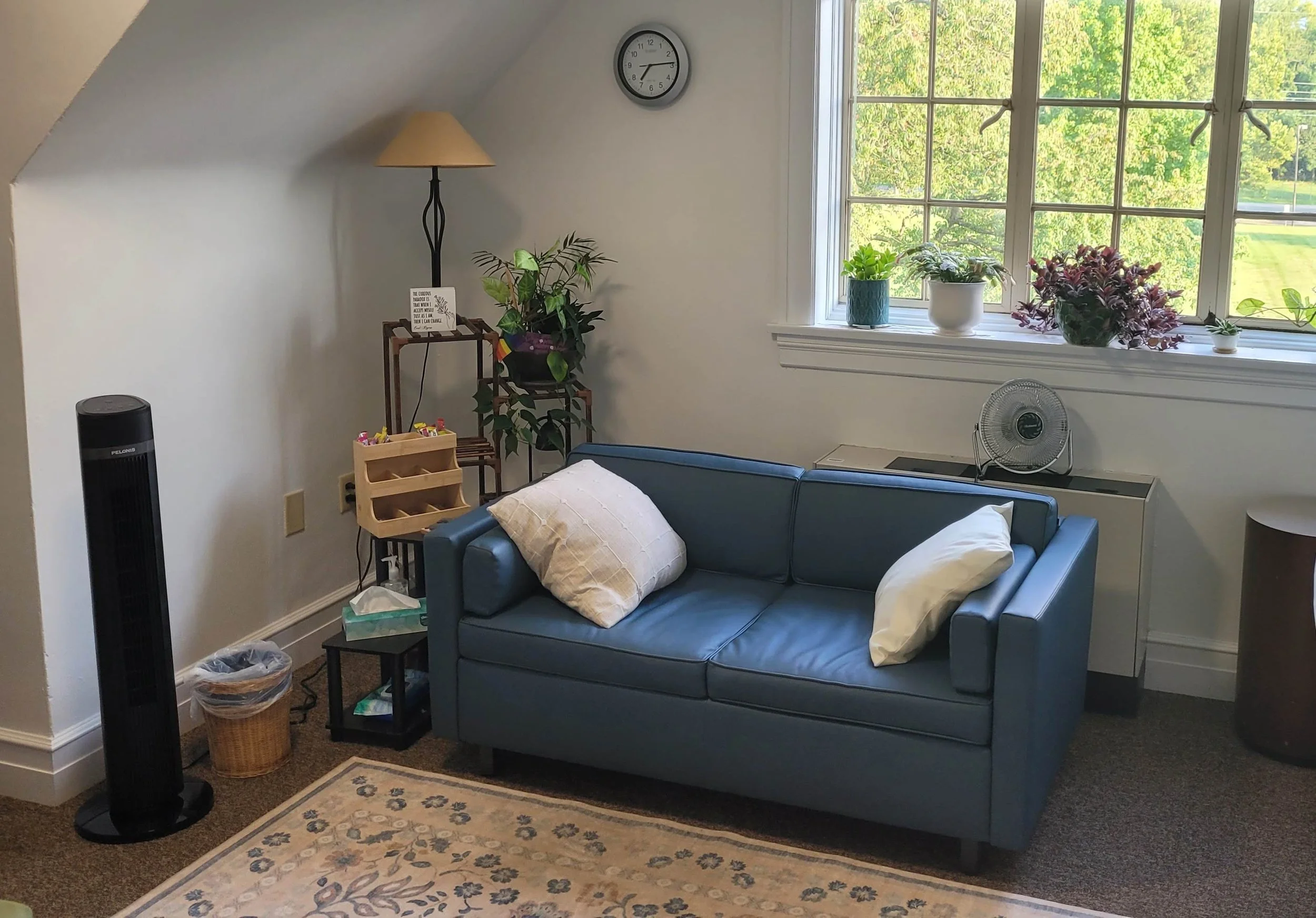“I am not just a therapist. I am a witness, a weaver, a wayfinder. I walk with others through the sacred terrain of emotion, and I trust the current beneath us.”
This isn’t just a mantra—it’s the heartbeat of my practice. I offer care that honors complexity, emotional truth, and the quiet power of being fully seen.
🧡 Where Healing Begins
Healing begins in the presence of another. When someone meets us with warmth, attunement, and care, something shifts. We feel safe, seen, and supported. The nervous system softens. The body remembers safety. The heart begins to speak.
In attuned presence, the brain can revise its stories and reshape the inner maps that guide how we relate to self, others, and the world. Therapy becomes a space not just to talk, but to feel—to be held, to be heard, and to slowly reclaim the parts of you that have been silenced or shamed. It’s a place where emotional truths can emerge without judgment, and where even the most guarded parts of you are met with curiosity and compassion.
This kind of healing doesn’t rush. It listens. It honors the pace your nervous system allows and the rhythm your story needs. In this space, you don’t have to perform or protect. You can arrive as you are—messy, tender, uncertain—and still be met with care. Together, we’ll build a relationship that can hold complexity, foster regulation, and invite transformation.
Healing is relational. It’s not a destination, but a process of returning—again and again—to connection, safety, and self-trust. And it begins here..
🧭 Therapeutic Approach
I work from an integrative model that blends attachment theory, psychodynamic insight, somatic awareness, mindfulness, and Emotionally Focused Therapy (EFT). My psychodynamic lens draws from relational and symbolic traditions—including Bion, Eekhoff, Ferro, and Winnicott, to explore how suffering lives in the body, in relationships, and in the stories we carry.
During sessions, we focus on how early relational patterns show up as unconscious or automatic responses in the present, shaping emotion, behavior, and connection. This exploration is central to our work. Depending on your needs, sessions may also include grounding techniques and body awareness practices. Together, we notice how protective parts respond to vulnerability, how the nervous system holds emotional risk, and how relational wounds echo through current experience.
I view attachment theory as the skeletal structure of mental health, a map for how we form, protect, and repair connection. The other modalities support and flesh out this framework, offering continuity across sessions while remaining flexible and responsive to your evolving needs. You can read more about each approach in the section below.
🤝 Attachment Theory
Attachment theory is the foundation of my work. It offers a lens for understanding how early bonds shape our sense of safety, trust, and intimacy—and how those patterns continue to influence our relationships, emotional regulation, and self-worth. These formative experiences create internal templates for connection: how we seek closeness, respond to conflict, and protect ourselves from vulnerability.
There are four primary attachment styles: secure, anxious, avoidant, and disorganized. Each reflects a different way of relating—how we reach for others, manage emotional needs, and respond to relational stress. While no style is fixed, exploring these patterns can illuminate our relational instincts and the protective strategies we've learned over time. Rather than pathologizing, we hold these styles with compassion—as starting points for insight, healing, and growth.
Together, we notice how these patterns show up in the present and gently invite new relational experiences. By bringing awareness to attachment wounds and longings, we begin to reshape the inner map that guides how we relate to ourselves and others. Healing attachment isn’t about erasing the past—it’s about rewriting the choreography of connection. Step by step, we learn new rhythms of safety, trust, and emotional presence.
🧠 Emotionally Focused Therapy (EFT)
EFT helps us tune into the emotional currents beneath our thoughts and behaviors—especially those shaped by attachment wounds, relational ruptures, and unmet longings. Emotions aren’t problems to fix; they’re messengers, guiding us toward what matters most: connection, safety, and belonging.
In our work together, we gently untangle the knots of emotional overwhelm, trauma, and relational pain that may have been stored in the body for years. These tangled places often hold unmet needs, protective strategies, and stories of survival. By slowing down and listening to these emotional signals with compassion, we begin to loosen what’s stuck—making space for new experiences of safety, intimacy, and self-expression.
EFT invites not just insight, but transformation. As emotional patterns shift, clients often find themselves reconnecting with their vitality, creativity, and capacity for growth. Healing becomes less about fixing and more about reclaiming the fullness of who they are.
🕯️ Psychodynamic Approach
Psychodynamic therapy invites us to explore the deeper emotional and relational patterns that shape how we move through the world. These patterns often live beneath the surface—woven into our unconscious, our bodies, and our earliest experiences of connection and rupture.
In our work together, I draw from the insights of David Wallin, Wilfred Bion, Antonino Ferro, Donald Winnicott, and Carl Rogers. I often act as a container for overwhelming or unprocessed emotional experience—holding it with care, and through reverie (a kind of intuitive, dream-like reflection) and attuned presence, I reimagine it and offer it back with new language and symbolism. When that offering resonates, clients begin to metabolize the experience with fresh meaning—allowing what once felt unbearable to become something understandable, even transformative.
Ferro’s emphasis on shared imagination helps us notice the stories that emerge between us—often subtle, symbolic, and emotionally charged. Wallin’s attachment-informed lens reminds us that healing happens in relationship: through attunement, reflection, and the creation of new relational experiences that support growth and integration. Winnicott’s vision of the therapist as a holding environment invites us to survive rupture together, while Rogers’ stance of unconditional positive regard and authenticity helps create a space where the true self can safely emerge.
Psychodynamic therapy honors the complexity of the psyche. It’s not just about insight—it’s about making space for what was once unspeakable, and gently inviting it into language, connection, and healing.
🧩 Internal Family Systems (IFS)
IFS invites us to meet the many parts within us—not as problems to fix, but as protectors, exiles, and messengers shaped by our lived experience. Each part holds a story: of survival, longing, shame, or resilience. These internal dynamics often mirror the attachment patterns we’ve known in relationships—with some parts striving for closeness, others guarding against vulnerability, and still others carrying the weight of wounds too tender to touch.
At the heart of IFS is the Self—a calm, compassionate presence that can become the secure attachment figure our parts have been longing for. Through gentle dialogue and deep listening, we build trust between the Self and the system, allowing protective strategies to soften and exiled parts to be witnessed, unburdened, and welcomed home.
This process isn’t just about insight—it’s about internal reparenting, relational repair, and the restoration of wholeness. As harmony returns to the inner system, clients often rediscover a sense of spaciousness, creativity, and emotional freedom. Healing becomes a homecoming.
🌿 Somatic Practices
Somatic practices bring attention to the body as a source of wisdom, regulation, and emotional insight. Many of our experiences—especially trauma—are stored not just in the mind, but in the nervous system, held in muscle, breath, and posture. By engaging breathwork, movement, grounding, and felt-sense awareness, we support the body’s natural capacity to process emotion and restore balance. These practices help us attune to subtle cues, reconnect with our physical selves, and cultivate safety from the inside out.
Somatic work is especially helpful when words feel distant or when emotional overwhelm needs gentle containment—offering a way to listen to what the body has been trying to say all along.
🧘 Mindfulness-Based Techniques
Mindfulness invites us to be present with our thoughts, emotions, and sensations—without judgment, resistance, or rush. Through practices like breath awareness, body scans, and compassionate observation, we learn to relate to our inner experience with more spaciousness and clarity. This includes noticing habitual thought patterns—those automatic loops that shape how we interpret ourselves and the world—and gently shifting our relationship to them. We begin to notice our thoughts the way we might watch clouds drift across the sky—shifting, forming, dissolving—without needing to chase or control them.
Over time, mindfulness helps interrupt reactivity, soften anxiety, and foster a more grounded sense of self. These techniques support emotional regulation, deepen insight, and create a foundation for intentional change. In therapy, mindfulness becomes both a mirror and a balm—a way to stay connected to the moment while honoring what arises with tenderness and curiosity.




